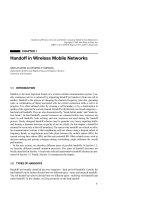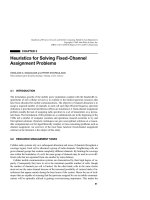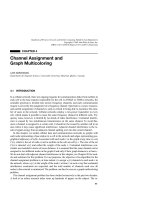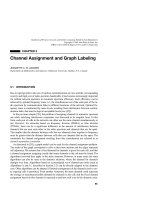Tài liệu Sổ tay của các mạng không dây và điện toán di động P12 doc
Bạn đang xem bản rút gọn của tài liệu. Xem và tải ngay bản đầy đủ của tài liệu tại đây (326.02 KB, 22 trang )
CHAPTER 12
Ensemble Planning for Digital
Audio Broadcasting
ALBERT GRÄF and THOMAS McKENNEY
Department of Music Informatics, Johannes Gutenberg University, Mainz, Germany
12.1 INTRODUCTION
It is expected that in many countries digital broadcasting systems will mostly replace cur-
rent FM radio and television technology in the course of the next one or two decades. The
digital media not only offer superior image and audio quality and interesting new types of
multimedia data services “on the air,” but also have the potential to employ the scarce re-
source of broadcast frequencies much more efficiently. Thus, broadcast companies and
network providers have a demand for new planning methods that help to fully exploit
these capabilities in the large-scale digital broadcasting networks of the future.
In this chapter, we consider in particular the design of DAB (digital audio broadcast-
ing) networks. Although channel assignment methods for analog networks, which are
usually based on graph coloring techniques (see, e.g., [3, 9, 11, 19, 21]), are also appli-
cable to DAB planning, they are not by themselves sufficient for the effective planning
of large DAB networks. This is due to the fact that, in contrast to classical radio net-
works, the DAB system transmits whole “ensembles” consisting of multiple radio pro-
grams and other (data) services, and allows an ensemble to be transmitted on a single
channel even if the corresponding transmitters may interfere. Hence, one can span large
areas with so-called single frequency networks, which makes it possible to utilize elec-
tromagnetic spectrum much more efficiently. To make the best use of this feature, how-
ever, it is necessary to integrate the planning of the ensembles with the frequency
assignment step. This is not possible with existing methods, which are all simply adap-
tions of known graph coloring techniques that are applied to a prescribed ensemble col-
lection.
We first show how to formulate this generalized planning problem, which we call the
ensemble planning problem, as a combined bin packing/graph coloring problem. We then
discuss some basic solution techniques and algorithms to compute lower bounds in order
to assess the quality of computed solutions. Finally, we develop, in some detail, a more ad-
vanced tabu search technique for the problem. Experimental results are used to point out
the strengths and weaknesses of current solution approaches.
267
Handbook of Wireless Networks and Mobile Computing, Edited by Ivan Stojmenovic´
Copyright © 2002 John Wiley & Sons, Inc.
ISBNs: 0-471-41902-8 (Paper); 0-471-22456-1 (Electronic)
12.1.1 Mathematical Preliminaries
We assume familiarity with the basic notions of graph theory (see, e.g., [8] or [14]) and
NP-completeness [7]. All graphs are simple, undirected, and loopless. The subgraph of a
graph G = (V, E) induced by a subset of vertices W ʕ V is denoted G
W
; it consists of the
vertex set W and all edges of G between the vertices in W. A coloring of a graph G = (V,
E) is a function f mapping vertices to “colors” in such a manner that f (v) f (w) ᭙ vw ʦ
E. If | f (V)| Յ k then f is also called a k-coloring. The chromatic number
(G) of G is de-
fined to be the minimum k for which such a k-coloring exists. The graph coloring problem
is, given G = (V, E) and integer k Ն 0, to decide whether G has a k-coloring. A clique of a
graph G = (V, E) is a subset W of V s.t. G
W
is complete, i.e., vw ʦ E ᭙ v, w ʦ W : v w.
The clique number
(G) is the maximum number of vertices in a clique of G, and the
clique problem is, given G and integer k Ն 0, to decide whether G has a clique of size at
least k. The clique number is an obvious lower bound on the chromatic number of a graph,
since all vertices in a clique must be colored differently (this bound is not tight as there are
graphs G for which the gap between
(G) and
(G) becomes arbitrarily large [8]). It is
well known that both the coloring and the clique problem are NP-complete. Moreover,
both problems are also difficult to approximate: the problem of determining a coloring
using at most |V|
1/7–
(G) colors, and the problem of finding a clique of size at least
|V|
–1/4
(G), are NP-hard for each
> 0 [6]. This implies, in particular, that it is not possi-
ble to approximate the optimization versions of these problems within constant perfor-
mance ratio in polynomial time, unless P = NP.
Another type of NP-complete problem we deal with in this chapter is the bin packing
problem. Given a set X with positive element sizes
x
, x ʦ X, and M > 0, an M-packing of
X is a set B of mutually disjoint subsets of X s.t. X = ʜ
B
ʦ
B
B and the total size
B
=
⌺
x
ʦ
B
x
of each “bin” B ʦ B is at most M. The bin packing problem is, given X,
, M and
a nonnegative integer k, to decide whether X has an M-packing B of size at most k. We also
let p
M
(X) denote the minimum size of an M-packing of X, called the M-packing number of
X. In contrast to the chromatic and clique numbers, the packing number can be approxi-
mated with good performance quite easily, using a simple kind of “greedy” procedure
known as the first-fit packing algorithm [7].
12.2 THE ENSEMBLE PLANNING PROBLEM
Two special aspects of the DAB technology motivate the problem discussed in this chapter:
First, a DAB frequency block usually carries several different radio programs and addition-
al data services. Therefore we have to deal with service ensembles instead of single radio
programs. Each service needs a certain bandwidth, and the total bandwidth of all services
forming an ensemble must not exceed the bandwidth available in a DAB frequency block.
Second, an ensemble may be transmitted on a single frequency block channel, even by
potentially interfering transmitters; collections of transmitters that all broadcast the same
ensemble on the same channel are called single frequency networks (SFNs). By making a
judicious choice of SFNs, one can often save a considerable amount of frequency re-
sources compared to conventional broadcast networks in which interfering transmitters
268
ENSEMBLE PLANNING FOR DIGITAL AUDIO BROADCASTING
must always be given different channels, even if they transmit the same signal. However,
to fully exploit the potential frequency savings, new planning algorithms are needed.
Therefore, in our approach to DAB network planning we not only consider the channel
assignment aspect, but also the search for ensemble collections that help to reduce the over-
all frequency demand. In our model, the network is described by a graph whose vertices cor-
respond to the (geographical) areas for which a certain service supply is to be provided. Two
vertices are connected by an edge if transmitters in the corresponding areas may interfere.
(In practice, the areas are usually polygons on the earth’s surface, and edges connect areas
that are within a given geometric distance, the so-called block repetition distance.)
The goal is to find ensembles that realize the desired service supply, and a correspond-
ing assignment of frequency blocks that prevents interference and minimizes frequency
requirements. We call this the ensemble planning problem. Thus an instance of the ensem-
ble planning problem consists of the following items:
ț A set S of services, where each service s ʦ S has a positive bandwidth
s
ț The area graph G = (V, E), where V is the set of areas and the edge set E is interpret-
ed as the interference relationship between areas
ț The requirements R
v
, v ʦ V, which denote, for each area v ʦ V, the set of services
to be supplied in that area
ț The maximum ensemble size M > 0
We generally assume (w.l.o.g.) that all bandwidths and the ensemble size are positive
integers. R and
are considered as functions R : V ۋ 2
S
and
: S ۋ ގ. In the following
we usually only specify the parameters G, R, and M and assume a corresponding service
set S with bandwidths
without further notice.
A solution to the ensemble planning problem consists of two items, an ensemble as-
signment and a corresponding block assignment. An ensemble assignment is a relation B
ʕ V × 2
S
, which assigns to each v ʦ V a set B
v
= {B : (v, B) ʦ B} of ensembles (service
sets) that are to be transmitted in the corresponding area. For an ensemble assignment B to
be admissible, it must satisfy the supply requirements, and the individual ensembles must
not exceed the maximum ensemble size:
R
v
ʕ
ʜ
BʦB
v
B ᭙ v ʦ V (12.1)
B
Յ M ᭙ B ʦ B
v
, v ʦ V (12.2)
where the total bandwidth
B
of an ensemble B ʕ S is defined by
B
= ⌺
s
ʦ
B
s
.
The second part of the solution is the block assignment f, which maps each (v, B) ʦ B
to a corresponding frequency block or “color” f (v, B). To be admissible, the block assign-
ment must not introduce any interferences, i.e., different ensembles in the same or inter-
fering areas must always be assigned different frequency blocks:
f (v, B) f (w, C) ᭙ (v, B), (w, C) ʦ B : B C ٙ (v = w ٚ vw ʦ E ) (12.3)
12.2 THE ENSEMBLE PLANNING PROBLEM
269
Finally, the target function to be minimized is the number of distinct frequency blocks,
i.e., | f (B)| = |{ f (v, B) : (v, B) ʦ B}|. We can now formulate the ensemble planning prob-
lem in the usual decision format as follows:
Problem 1 (Ensemble Planning Problem) Given G = (V, E), R : V ۋ 2
S
, M ʦ ގ and K
ʦ ގ, decide whether there is an admissible ensemble assignment B and corresponding ad-
missible block assignment f s.t. | f (B)| Յ K.
In the following, for given G, R, and M, by
M
R
(G) we denote the minimum number of
frequency blocks in any admissible solution. It is not difficult to see that the admissible
block assignments f for a given ensemble assignment B actually are in one-to-one corre-
spondence to the valid colorings of an associated ensemble graph G
B
which has B as its set
of vertices and whose edges are precisely those pairs (v, B)(w, C) for which B C ٙ (v =
w ٚ vw ʦ E); cf. Equation (12.3). Consequently we have that
M
R
(G) = min{
(G
B
) : B admissible} (12.4)
Hence the ensemble planning problem is nothing but a graph coloring problem on top of a
kind of packing problem. We further explore this in the following sections.
Example 1 Consider the problem instance in Figure 12.1, which involves five areas I–V
and eight services A–H. We assume that only adjacent areas (such as I and V, or II and IV,
but not I and IV) interfere. Thus, the area graph in this case is W
4
, the wheel with 4
spokes, where area V forms the hub of the wheel. The requirements R
v
and service band-
widths
s
are given in the figure. The maximum ensemble size is M = 9.
Our task is (1) to arrange the services into a collection of ensembles for each area (this
is what we call the ensemble assignment), and (2) to assign channels to the resulting en-
270
ENSEMBLE PLANNING FOR DIGITAL AUDIO BROADCASTING
Figure 12.1 Ensemble planning problem.
s
s
s
s
A4 E4
B3 F1
C5 G1
D7 H2
M = 9
sembles (this is the block assignment). We want to do this in such a manner that the condi-
tions (12.1), (12.2), and (12.3) are satisfied. And, of course, we want the number of re-
quired frequency blocks to be as small as possible. (This is the hard part.)
Figure 12.2 shows two different solutions. The first solution (on the left-hand side) is
fairly straightforward: we simply pack the services required for each area into a minimum
number of ensembles. We call such an assignment, which supplies each area exactly with
the requested services, a strict ensemble assignment. It is easy to see that this solution re-
quires five frequency blocks in order to avoid interference and, in fact, one can show that
in this example each strict ensemble assignment needs at least five frequencies.
It is possible to do better than this, but only if we allow a certain degree of “oversup-
ply,” as shown in the second solution. Here, we packed the entire service collection into
three different ensembles, which can then be transmitted using three frequency blocks. It
can be shown that this solution is indeed optimal. Thus we see that in DAB networks it is
possible to save frequencies through oversupply.
12.3 BASIC SOLUTION TECHNIQUES
It is not difficult to see that the ensemble planning problem is NP-complete; in fact it con-
tains both the graph coloring and the bin packing problem as special cases. (For the graph
coloring problem, take S = V, R
v
= {v} ᭙ v ʦ V and
ϵ 1 = M; for the bin packing prob-
lem, let G be a one-vertex graph.) So we know that Problem 1 is not only NP-complete,
but also difficult to approximate and, hence, we will be interested in heuristic solutions.
How can we approach this problem? We have already mentioned that the problem re-
duces to an ordinary graph coloring problem once we have obtained a suitable ensemble
assignment. Thus a straightforward approach is to solve the problem in two optimization
stages:
12.3 BASIC SOLUTION TECHNIQUES
271
Figure 12.2 Two ensemble/block assignments.
ț Find an admissible ensemble assignment B.
ț Color G
B
using some heuristic graph coloring procedure.
For the second stage, a plethora of different graph coloring algorithms is already avail-
able. In fact, it turns out that fairly simple “sequential” coloring methods like Brélaz’
DSATUR [2] or Matula/Beck’s smallest-last algorithm [16] usually perform very well on
the kind of “geometric” graphs arising as models of broadcast networks. So we can con-
centrate on the first step, which is a kind of simultaneous bin packing problem. The diffi-
cult part here is to devise a packing strategy that reduces the global number of required
colors instead of merely optimizing the packings for individual areas. Of course, no single
strategy will work with all area graphs equally well, so let us take a look at the two ex-
treme cases:
ț Independent (edgeless) graphs. In this case the problem decomposes into |V | inde-
pendent bin packing problems, one for each vertex of G, and we have that
M
R
(G) =
max{p
M
(R
v
) : v ʦ V}.
ț Complete graphs. In this case, all distinct ensembles will have to be assigned differ-
ent frequency blocks, hence
M
R
(G) = p
M
(R
V
).
(Here and in the following, by R
W
we denote the set of all requested services in a set of
areas W ʕ V, i.e., R
W
= ʜ
wʦW
R
w
. Thus, in particular, R
V
is the set of all requested ser-
vices.)
This suggests two different types of ensemble packing heuristics that we would ex-
pect to work reasonably well with sparse and dense graphs, respectively. For sparse
graphs, we will pack the individual requirement sets independently of each other. For
dense graphs, we will pack the entire collection of requested services, and then assign to
each vertex those ensembles that are needed to satisfy the supply requirements at that
vertex. For an arbitrary graph, we might try both approaches and see which one works
best.
Since the bin packing problem is NP-complete, we need some heuristic for solving it.
A simple method, which works reasonably well, is the so-called first-fit (FF) algorithm,
which considers the items (a.k.a. services) to be packed in some order, and puts each item
into the first “bin” (a.k.a. ensemble) into which it fits. It is well-known that if the items are
ordered by decreasing sizes, this method never performs worse than 11/9 times the opti-
mum (asymptotically). (We refer the reader to [7] for the details of this algorithm and its
analysis.)
In the following, we use FF(R, M) to denote the set of ensembles returned by the first-
fit algorithm when applied to a set of required services R ʕ S and the ensemble size M.
We can employ the first-fit algorithm for packing ensembles using the two strategies
sketched out above, as follows:
Simultaneous First-Fit (SFF) Algorithm:
B
v
= FF(R
v
, M) ᭙ v ʦ V (12.5)
272
ENSEMBLE PLANNING FOR DIGITAL AUDIO BROADCASTING
Global First-Fit (GFF) Algorithm:
B
v
= {B ʦ FF(R
V
, M) : B ʝ R
v
0/} ᭙ v ʦ V (12.6)
Incidentally, the two algorithms also correspond to the two solution approaches taken
in Example 1. The SFF algorithm computes strict solutions (ensemble assignments exact-
ly satisfying the requirements), aiming at “local optimality” by avoiding oversupply. In
contrast, the GFF algorithm strives for “global optimality,” producing overlap-free solu-
tions in which the constructed ensembles are mutually disjoint (i.e., each service will only
be supplied in a single ensemble for all areas where it is requested). As already indicated,
we would expect SFF to work best with sparse, and GFF with dense graphs. In fact, the
performance bounds for the first-fit bin packing algorithm directly carry over to SFF and
GFF solutions. That is, a (properly colored) SFF (resp. GFF) assignment on an indepen-
dent (resp. complete) area graph using a service order by decreasing bandwidths will at
most be about 22% off the optimum (asymptotically).
As pointed out by Schmeisser [22], SFF (when ordering services by decreasing band-
widths) produces ensemble assignments which can be colored using at most (11/9)
(G)
colors (asymptotically), whereas GFF can perform arbitrarily bad even if the area graphs
are acyclic (and hence bipartite). However, in experiments with geometrically defined
area graphs [10] we found that GFF usually performs much better than SFF when the area
graphs are dense, or when the services have a high average “circulation” (defined as the
percentage of areas requiring a given service).
12.4 LOWER BOUNDS
When dealing with heuristics for NP-hard minimization problems, one is always interest-
ed in finding a good lower bound on the optimal solution, which allows us to assess the
quality of computed solutions. For the ensemble planning problem, a useful bound is pro-
vided by an appropriate generalization of the clique number, which we discuss in this sec-
tion.
As in the preceding section, we let R
W
= ʜ
wʦW
R
w
᭙ W ʕ V. Similarly, the set of all en-
sembles in a given area set W ʕ V is denoted B
W
, i.e., B
W
= ʜ
wʦW
B
w
. The quantity we con-
sider, which we call the clique packing number, is defined as follows:
M
R
(G) = max{p
M
(R
W
) : W clique of G} (12.7)
To see why
M
R
(G) is in fact a lower bound on
M
R
(G), let W ʕ V. It is easy to see that,
if B is an admissible ensemble assignment w.r.t R and M, then |B
W
| Ն p
M
(R
W
). Now con-
sider the special case that W is a clique of G. In this case, the subgraph of G
B
induced by B
ʝ (W × B
W
) always contains a clique of size |B
W
|. (For each B ʦ B
W
choose some w
B
ʦ W
s.t. B ʦ B
w
B
. Then {(w
B
, B) : B ʦ B
W
} is a clique of the requested size.) Hence
p
M
(R
W
) Յ |B
W
| Յ
(G
B
) Յ
(G
B
) (12.8)
12.4 LOWER BOUNDS
273
By taking the maximum over all cliques W of G on the left-hand side of Equation
(12.8), and the minimum over all admissible ensemble assignments B on the right-hand
side, we obtain the desired inequality
M
R
(G) Յ
M
R
(G) (12.9)
The clique packing number is a weighted generalization of the clique number which,
instead of merely counting the vertices contained in a clique, weights cliques according to
the packing number of their requirements. Although computing the clique packing num-
ber is NP-hard, in practice it is much easier to approximate than other lower bounds like
the minimum
(G
B
), for which we would have to consider all admissible ensemble assign-
ments. Here we can employ a generalized version of the Carraghan/Pardalos algorithm, a
branch-and-bound method for computing the clique number of a graph [4], which we have
found to work quite well on not too dense graphs with a few hundred vertices. The algo-
rithm can also be terminated at any time to give a lower bound on the clique number. It
can easily be adapted to any weight function which is “monotonous” in the sense that if W
ʕ WЈ, then the weight of W is at most the weight of WЈ.
One complication is that since the bin packing problem is NP-complete, we can only
approximate the clique weights. That is, we actually compute a lower bound
M
R
(G) = max{ f (R
W
, M) : W clique of G} (12.10)
on the clique packing number, where f (X, M) is a lower bound on p
M
(X) that can be com-
puted efficiently. A simple method is to employ the “sum bound”
f (X, M) =
X
/M (12.11)
which is always at least half the packing number. A better lower bound for approximating
the clique packing number is discussed in [22].
Example 2 In Example 1, the areas I, II, and V form a clique of the area graph whose re-
quested services sum up to a total bandwidth of 25. Hence, the clique packing number for
this instance is at least 25/9 = 3, which proves that the solution with 3 frequency blocks is
optimal (and also shows that the clique packing number is exactly 3). Note that in this ex-
ample we have
M
R
(G) =
M
R
(G). This is not true in general; just as with chromatic and clique
numbers, there may be a “dual gap” between
M
R
and
M
R
that can be arbitrarily large.
12.5 A TABU SEARCH METHOD
As pointed out in the previous section, the SFF and GFF algorithms represent two basic
solution ideas for the ensemble planning problem (EPP), GFF (in contrast to SFF) taking
advantage of the possibilities to reduce the demand of frequencies needed by oversupply-
ing some or all of the vertices v ʦ V of the area graph G = (V, E) with services s ʦ S not
necessarily required (s R
v
). We will see later that for quite a few problem instances SFF
274
ENSEMBLE PLANNING FOR DIGITAL AUDIO BROADCASTING









